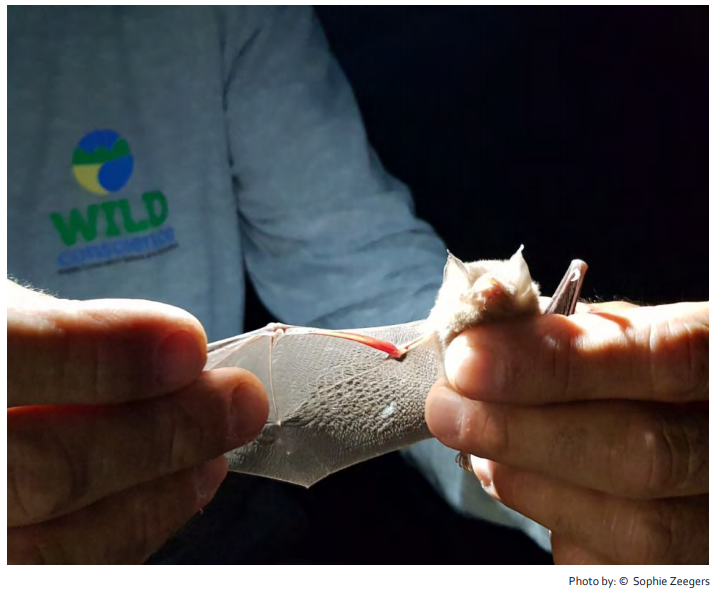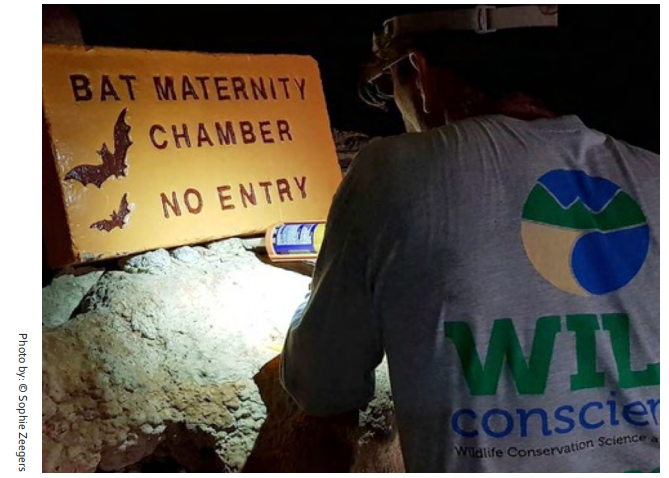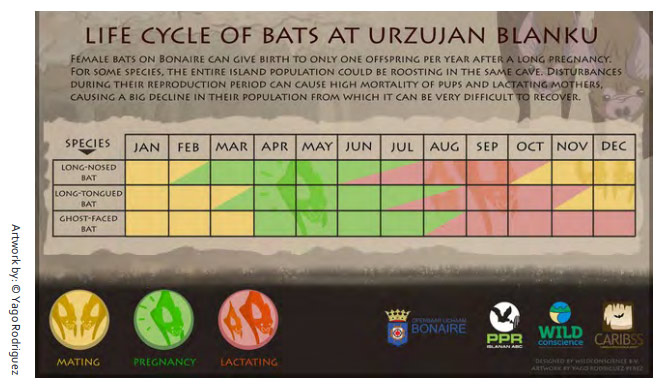Historical bat and cave protection on Bonaire over the last two decades.
Bonaire has an extensive cave system which is unknown to many visitors. The ecological importance of these cave habitats was recognized many years ago when a group consisting of individuals residing on Bonaire and governmental representatives worked to begin mapping Bonaire’s caves. This unofficial group also invited and hosted scientists to the island in order to begin studies on the island’s caves.
After several years, STINAPA took over with bat research and, to this day, helps instill the importance of Bonaire’s caves in the resident population via their educational bat night events.
Today, there is even more protection for Bonaire’s caves, thanks to generous funding from the Ministry of Agriculture, Nature and Food Quality (LNV) through the Nature Fund, as the island is seeing the establishment of its first cave reserve, the Bonaire Caves and Karst Nature Reserve.
The Bonaire Caves and Karst Nature Reserve
As a pilot project, a 30-hectare cave park is being created in Barcadera due to the high density of caves and sinkholes in the area. The two-year project, which began in the summer of 2017, is a partnership between WILDCONSCIENCE, Openbaar Lichaam Bonaire (Public Entity Bonaire) and The Caribbean Speleological Society (CARIBSS) with the goal of providing optimum protection and management for the natural, cultural, recreational, and scientific values contained in the Bonaire Cave System through activities in cave management, bat scientific research, and education.

“One of the most important things that we will be doing is to classify the caves of the park according to their fragility and values. In this way, we can designate them into categories that will indicate if they can be accessed freely, only under the supervision and leadership of a certified cave guide, and during which periods of the year this will be possible.” – Fernando Simal, project leader & co-managing director of WILDCONSCIENCE
Bonaire’s unique geological past created an extensive cave and sinkhole network.
Bonaire has a rich and complex geological history which is reflected in its current geological landscape. While the core of the island is comprised of volcanic rocks, the coastline and north of the island are made up of limestone formations such as coral-rubble beaches and limestone cliffs. Centuries of water erosion on these cliffs has resulted in extensive freshwater and marine karst (limestone) complexes with extensive caves systems. The majority of the island’s estimated 200 caves are either hard to access or submerged, but several caves are open to the public with little supervision or management. As a result, the many important ecological, cultural, and historical values of the caves are threatened by unregulated visits and illegal activities such as vandalism and waste dumping.
The caves host unique species found exclusively on Bonaire and are home to Bonaire’s five species of bats.
Bonaire’s karst and caves are extremely valuable natural resources with a rich variety of plants and animals. They typically host unique ecosystems that provide a habitat for unique species; several endemic species of shrimp, fish, and brotulas with special adaptations are known to occur exclusively in Bonaire’s caves. The caves are an especially important habitat for five of the island’s species of bat, which in turn play a key role in maintaining the island’s biodiversity. Two of Bonaire’s nectar-eating bat species (Leptonycteris curasoae and Glossophaga longirostris) are highly inter-dependent with columnar cacti and agaves. They rely upon the cacti and agaves for food resources, and these plant species, in turn, rely upon the bats for pollination services and for some seed dispersal. The three insectivore cave-dwelling species of bat (Mormoops megalophylla, Myotis nesopolus, and Natalus tumidirotris) help control the island’s insect population, notably mosquitoes.
Some of the caves have great cultural and historical value due to the ancient inscriptions preserved in them. Rock paintings and petroglyphs have survived at the caves at Spelonk, Onima, Ceru Pungi, and Ceru Grita-Cabai. Many also have impressive speleological formations that are of great interest to both geologists and visitors. While several positive measures have recently been taken to protect and manage the island’s caves (e.g. inclusion of caves in the ROB in 2010, the new Nature Ordinance, covenant between local government and the cave tour operators), there is currently no proper management of cave tourism due to a lack of capacity and funds. The many values of the caves are threatened by invasive species of fauna and flora as well as unsupervised visits and explorations that do not respect the caves’ fragile ecosystem and carrying capacity.
Goals of the new Bonaire Caves and Karst Nature Reserve.
Improve cave tourism on Bonaire and reduce visitor impact.
One of the main goals of the Bonaire Caves and Karst Nature Reserve project is to significantly improve cave tourism on Bonaire, reducing the impact of visitors as much as possible, especially in the bat maternity caves, while giving them an upgraded and educational experience. The project aims to make cave visits and tours controlled, safe, educational, non-damaging, and non-disturbing.” The park is set to have approximately 10 caves open to visitors to avoid overcrowding and make sure cave tourism is sustainable.


Training the cave guides is another goal.
In order to ensure that visits are well guided and controlled, CARIBSS will offer a Bonaire dry cave guide certification course. During the course, guides will be trained on such things as adequate emergency response protocols, proper caving techniques, and safety procedures. A key focus of the Bonaire Caves and Karst Nature Reserve is the education of visitors, from safety to the many different values of the caves and the surrounding habitat. Approximately four kilometers (2.5 miles) of walking trails are currently being built, with the trails connecting some caves and sinkholes. The trails will have nature interpretation signs that feature the geology, flora, and fauna of the surrounding limestone terraces. Signage will also highlight and explain the different values of the caves, and easy to read cave maps will showcase the different levels of difficulty, access restrictions, and safety indications. Guides who have completed the certification course will be equipped with the knowledge to provide visitors with information about the ecological and historical importance of caves.
Approximately 2.8 kilometers (1.75 miles) of fencing will surround the park to keep invasive herbivores away (feral donkeys, goats, sheep, and pigs) and give native vegetation a chance to recover from decades of overgrazing. Existing waste is also being removed. On five other caves outside the park, motor vehicles will not be permitted within 100 meters of the caves to reduce illegal waste dumping.
Protection of keystone species will have a high priority.
Another chief goal of the Bonaire Caves and Karst Nature Reserve is to ensure the protection of five keystone species for the island and their ecological interactions: two species of nectar-feeding bats (Glossophaga longirostris and Leptonycteris curasoae) and the three species of candle cactus that they pollinate. “Bat-plant mutualistic interactions are vital for sustaining life in arid and semiarid ecosystems” explains Fernando Simal, “the protection of this ecological interaction will benefit the entire trophic web that depends on it, which includes many species of terrestrial birds, reptiles, and invertebrates.”
Bats rely heavily on caves as diurnal and maternity roosts. The caves that serve as maternity roosts are especially vital to the survival of the island’s bat population and must, therefore, receive special protection. The Bonaire Caves and Karst Nature Reserve at Barcadera will include two of the island’s five most important maternity chambers, where at least three of Bonaire’s cave-dwelling bat species are known to complete their life cycle, including pregnancy and lactation. These maternity chambers will be fully protected by physical barriers and information signs. Research is also being conducted to understand the temporal patterns of use at a new maternity cave located at the southeast of the island by the insectivore species Myotis nesopolus and Natalus tumidirostris.


Future plans for cave protection.
The Nature Funded Bonaire Caves and Karst Nature Reserve is the first part of what is hoped will become one of the Caribbean’s best managed and protected cave parks. Next on the horizon is the application for SICOM (Site of Importance for Bat Conservation) status for the maternity caves of Myotis nesopolus and Natalus tumiridostris, which will be used as a tool to provide legal protection for the caves. To support this application, CARIBBS will be creating maps of the caves and carry out research to estimate population size, the yearly pattern of roost use, and the life cycle of species. Relative abundance of the species will be estimated by setting harp traps and/or mist nets at the exit of this newly investigated cave.
Components of this article have been reprinted from the 14th issue of BioNews, the nature newsletter of the Dutch Caribbean Nature Alliance.
(Source: Dutch Caribbean Nature Alliance, reprinted with permission)










